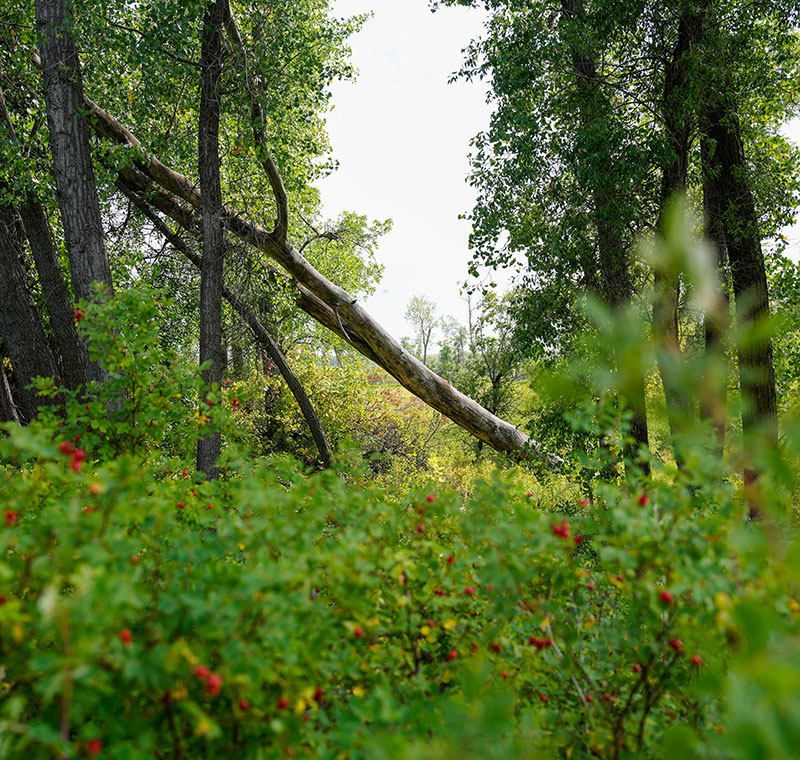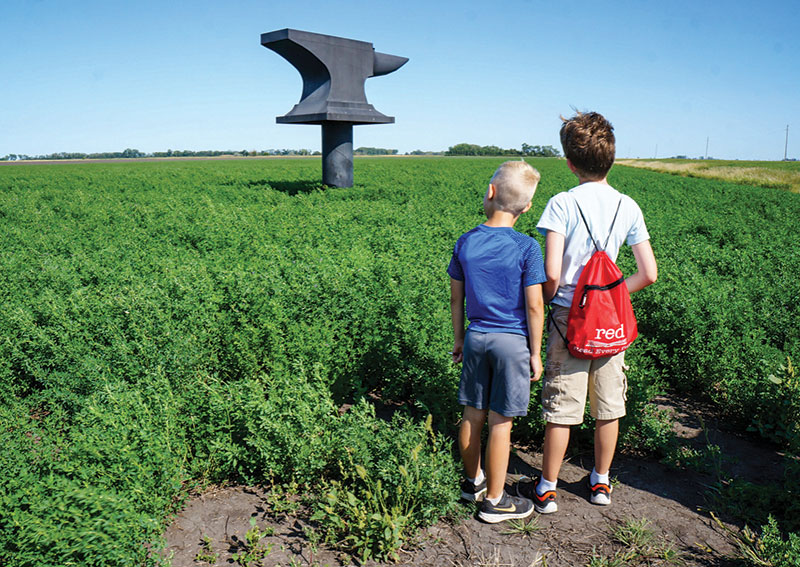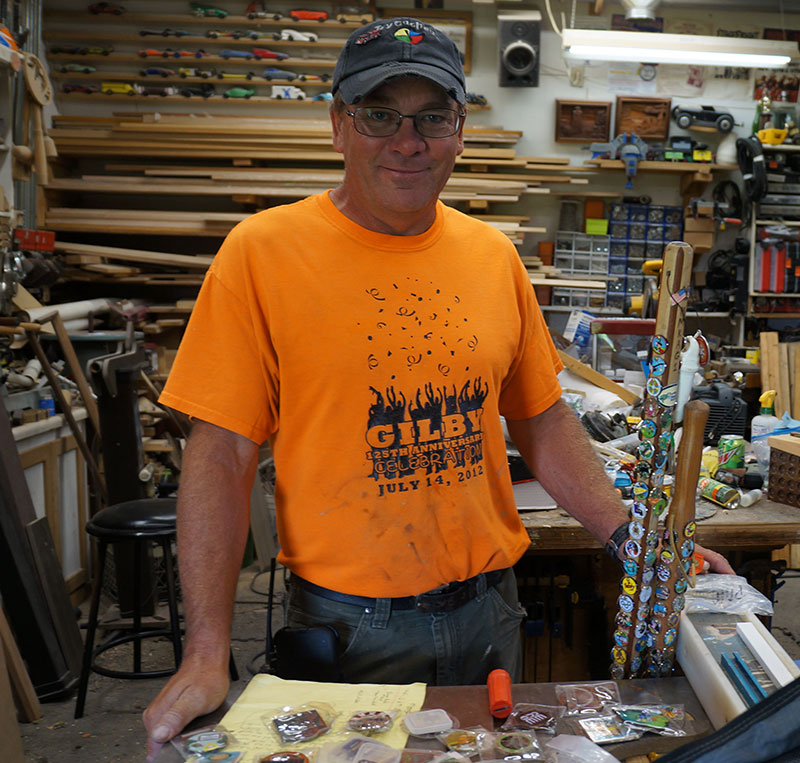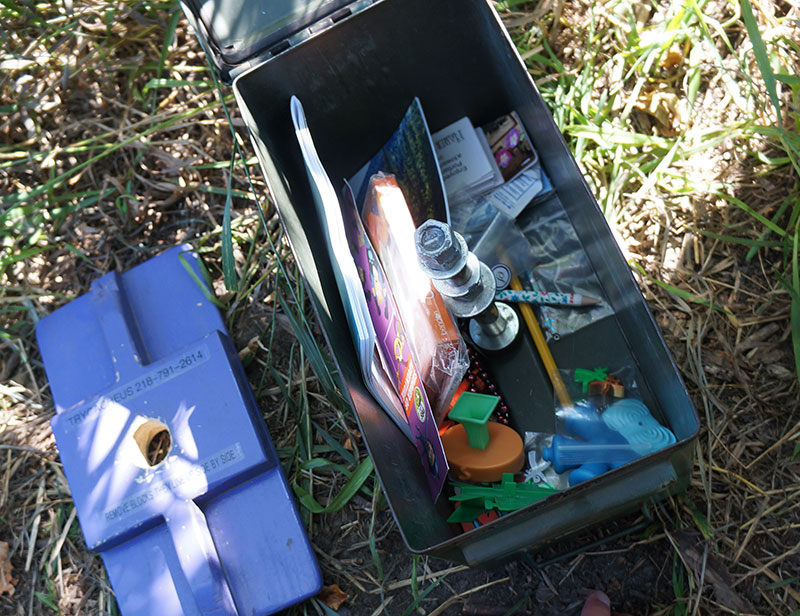Hidden in Plain Sight
Alicia Underlee Nelson
(A freelance travel writer and photographer from West Fargo. She blogs frequently about travels within North Dakota on her website, prairiestylefile.com)

What do a giant anvil in an alfalfa field, an ammo can stuffed with loot in a shelter belt and a pneumatic tube hidden next to a historic train station have in common? They’re all part of a worldwide treasure hunt. And they’re all right here in North Dakota.
North Dakota is a geocaching hot spot. Its unlikely star attraction is Gilby, a proud little farming community northwest of Grand Forks. This tiny town is known as the Disneyland of Geocaching, thanks to a series of brainteasers created by Chad Thorvilson, an expert cache maker who goes by Trycacheous in the geocaching community.
Visitors drive here from surrounding states and Canadian provinces to the north and west. They fly in from Texas, Alaska and Hawaii. They stop to look for goodies stashed in North Dakota state parks, to find trinkets at historical sites near the Canadian border, and to try a city-wide treasure hunt in Fargo-Moorhead. There are geocaches in every major city in North Dakota and at least one cache in all the state’s 53 counties.
But if you’re like many North Dakotans, you had no idea. You drive right by concealed caches, oblivious, mistakenly certain that you know your own neighborhood inside and out. You assume there are no surprises in this familiar landscape, no mysteries to be found, and certainly no hidden treasure. But you’re wrong.
That changes now. This is your initiation into the world of geocaching, an addictive pastime and thriving subculture with deep roots in North Dakota.
What is geocaching?
Geocaching is an outdoor activity, a treasure hunt, a global game of hide and seek. Seekers called geocachers use a Global Positioning System receiver, mobile phone or other navigational tools to find containers (called caches) hidden at specific coordinates across the globe – and beyond.
“There’re 191 countries that have geocaches,” said Thorvilson. “There are over 3 million of them in the world. There was even a trackable tag put on the Mars Rover.”

The accuracy of modern GPS technology improved immensely on May 2, 2000. GPS enthusiasts (and fans of orienteering and older forms of navigational scavenger hunts like wayfaring and letterboxing) took notice. The very next day, a man named Dave Ulmer decided to see just how accurate this new GPS technology was. He placed a bucket in the woods in Oregon and listed the coordinates online. It was found within days and geocaching was born.
How does Geocaching Work?
The rules of geocaching are simple. Follow the GPS coordinates and written clues to find a cache. Sign the log, take a trinket, and leave one of equal or greater value.
Then put the cache back exactly where you found it. Use stealth to avoid drawing attention from nearby “muggles” (non-geocachers) who might be curious about why you’re poking around along the tree line or nonchalantly reaching behind a road sign. Don’t worry about trespassing – cache hiders need to get permission from landowners before placing a find on their property.
How do I start?
Download the official geocaching app or go to geocaching.com to look for coordinates to enter into your GPS device. The app is free and perfect for new and intermediate geocachers. (You can always pay to upgrade later if you want more features.) There are other geocaching apps out there, but this one is highly rated and extremely user-friendly.
Search for caches by destination, or just center the map on your location to see what’s hidden nearby. Then grab a pen and a few prizes to trade and you’re ready to go. You probably won’t have to travel far.
Start Close to Home
Tanya Harmon started geocaching about 20 years ago, back when treasure hunters had to go online and print out a map. By the time her son, Devin, 14, and daughter, Riley, 12, were ready to try geocaching, this West Fargo family could just grab a phone and hit the road.
“I wanted to find something to get the kids out of the house and something that both kids would enjoy,” Tanya Harmon said. “So, we went to Lindenwood Park the first time.”
The Harmons logged a handful of caches at that Fargo park on their first attempt. Riley and Tanya have found a few more around the state, including some in Grahams Island State Park near Devils Lake. But Riley’s favorite is just a few blocks from home.
“There was one behind Costco that I did with my mom that was really fun,” she said. “We had to find a combination to a lock. I like how some of them have a mystery to solve and you have to look around for clues.”
Start with Easy Finds
Like Tanya Harmon, Mark Elton started geocaching with a computer and a paper map. The Moorhead, Minn., resident frequently brings friends (and brand new geocachers) across the border to search for caches in Fargo.
“For people who are just starting out, definitely use the filter on the app,” he said. “Go for the easy ones first.”
This isn’t as hard as it sounds. When you download the free app, it only shows you the easier caches. Premium users who pay a monthly or annual fee to upgrade can filter by the difficulty of the cache or the terrain. Amy Schimetz, a geocaching enthusiast and interpreter/OLC coordinator at Lake Metigoshe State Park, explained the rating system.
“All geocaches are rated on difficulty and terrain on a 5-star rating (system), where one is easy and five is most difficult,” Schimetz said. “Difficulty rating refers to the difficulty level surrounding finding the container, whether you are solving a clue, looking for a camouflaged cache or even needing specialized knowledge or skills to find, solve or open a cache. Terrain refers to the physical effort needed to arrive at the cache location. A terrain level of one would likely be paved and accessible by a wheelchair, whereas a five would require special equipment such as scuba gear, rock climbing gear, a boat, etc.”
Very high terrain ratings aren’t common in the Midwest, especially in North Dakota where the landscape is flat. (I haven’t seen anything higher than a three so far.) Many caches are tucked into city parks and located near attractions where parking is plentiful. Some are actually hidden in parking lots.
Stick with It
“Don’t get too frustrated if you don’t find anything in the first 5 minutes,” said Devin Harmon. “And bring water.” (This is sound advice. New geocachers sometimes forget basic outdoor safety tips like staying hydrated, wearing proper clothing, and applying sunscreen.)
“The camouflage can get really tricky sometimes,” said Mark Elton. “There are a lot of different types of caches. Pill bottles and ammo cans are very common, but there are also magnetic key holders and false magnetic electrical plates. But if you’ve never come across a false electrical plate, you’ll just walk by it. So, the more you go geocaching and the more variety of caches you find, the easier it becomes.”
Go for the Bigger Prizes
Kids of all ages (even the grown-up ones) get a kick out of a prize every now and then. So, skip the micro caches at first and concentrate on larger containers.
“If I’m going to get people to go geocaching and all we find is a tiny little pill capsule with only enough room for a log, that’s not as interesting as if I pull out an ammo can or a treasure chest full of little treats,” said Elton. “With a bigger cache, kids can pull out a little toy. And sometimes they can even find money, so it’s a lot more rewarding.”
Bring your own prizes to replace what you take. Small items like pencils, erasers, coins, keychains, and little toys work well. So do paper products like bookmarks and stickers, especially if they’re encased in plastic to protect them from the elements. Don’t leave food, liquids, illegal or adult items or weapons behind.
Once you’ve gotten the basics down, you’re ready to challenge yourself. Find cool caches in your area, earn souvenirs on the app or take a geocaching road trip.
Earn Souveniers
Geocachers get souvenirs (virtual badges) for logging finds on the app and online. But you can also get one for finding a cache during World Geocaching Day (August 20) or Blue Switch Day (May 2), the date that more accurate GPS technology became available to civilians.
You can earn souvenirs for geocaching in different cities and countries, too. So, throw in a few trinkets when you’re packing for your next hunting trip or family vacation. Geocaching is an immersive way to get to know a new place. And it makes stopping for food, fuel and bathroom breaks along the way a lot more interesting.
Go Geocaching in North Dakota State Parks
You don’t have to travel out of state to find a new geocaching challenge. Eight of North Dakota’s 13 state parks have geocaches within their borders. They include Cross Ranch State Park and Fort Stevenson State Park along the Missouri River, Lewis and Clark State Park in the northwest and Fort Ransom State Park in the southeast.
The northeastern corner of the state boasts four of the most popular geocaching parks. Grahams Island State Park outside Devils Lake, Icelandic State Park near Cavalier, Turtle River State Park northwest of Grand Forks and Lake Metigoshe State Park along the North Dakota-Manitoba border attract geocachers from both the U.S. and Canada. The scenery is a draw. So is the concentration of caches.
“Geocaching within a couple of our parks offers a cluster of caches that can be found in a smaller, local area,” said Schimetz. “For example, Lake Metigoshe and Turtle River state parks each offer 10 caches and Icelandic State Park currently has five caches hidden within its boundaries. A trip to these locations will be more than worth it for a cacher looking to add to their list of total caches found.”
Geocaching in a state park is a low stakes way to introduce people to the hobby since there are other activities available. It can also help families go deeper into nature and see a familiar park in a new way. The North Dakota Geocaching Association offers monthly state park geocaching hikes. Newcomers are welcome.
Pembina Walsh Historic Trail
Other North Dakota destinations are thinking outside the box to connect geocaching and tourism as well. The Pembina Walsh Historic Trail in northeastern North Dakota recruited Thorvilson to add gadget caches near some of the region’s historical sites. Geocachers can go to rendezvousregion.com/download/passport.pdf to download the PWHT passport. When you log five finds in each county, you’ll score two commemorative pathtags. There are over three dozen caches to choose from.
“The way they’re rolled up into the history is just amazing,” said Thorvilson. “The fun caches are what draw people to North Dakota.”
Make a Pilgrimage to Gilby
But no caches draw people to North Dakota quite like Thorvilson’s caches. There’s a reason that this cheerful, unassuming former Cub Scout leader is recognized at international geocaching events, profiled by geocaching YouTubers and greeted with squeals of delight by complete strangers who leap out of their cars to shake his hand outside of the Gilby farmhouse he shares with his wife, Jane.
“The caches I have found there have been so beautifully gamified that it spoils every other cache,” Elton said. “It’s hard to find caches that are that good.”
They’re also cheeky, clever and occasionally laugh out loud funny. Like a good mystery novel, these caches include plenty of red herrings and witty wordplay. Some require you to throw a baseball, arrange magnets, or use robotics. In one, you seek help from a Looney Tunes character. In another, you pick up a mallet and strike a piece of wood with all your strength, sending the cache soaring up into the air.
The Gilby caches are only visible to premium subscribers, so they attract experienced geocachers. But it doesn’t matter if you ever make a pilgrimage to the Disneyland of Geocaching. When you find your first cache, you become a part of this secret community. And you’ll never see North Dakota the same way again.
Tips

You never know what you’ll find while geocaching in North Dakota.
What You Need to Get Started
- A smartphone with the Geocaching app or a GPS unit and website access
- Pen or mechanical pencil
- Small prizes and trinkets
Handy to have
- Water
- Sunscreen, hat and raingear
- Scratch paper
- Bug spray
- Snacks
Tools for Advanced Geocachers
- Screwdriver
- Telescopic magnet
- Flashlight
- Tape measure (12 feet or longer)
- Crescent wrench
- Plier
- Tweezers


